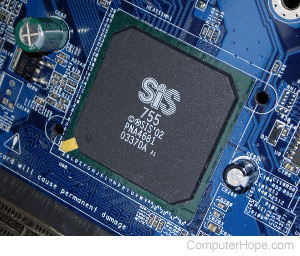Northbridge

Alternatively called the PAC (PCI/AGP Controller) and nb, the northbridge is an integrated circuit responsible for communications between the CPU (central processing unit) interface, AGP (accelerated graphics port), and the memory. Unlike the southbridge, the northbridge is directly connected to these components. It acts as a "bridge" for the southbridge chip to communicate with the CPU, RAM (random-access memory), and graphics controller. Today, the northbridge is a single chip North of the PCI (peripheral component interconnect) bus; however, early computers may have had up to three separate chips that made up the northbridge.
Below is a graphic illustration of the ASUS P5AD2-E motherboard and labels for each motherboard component, including the northbridge. As shown, the northbridge and southbridge commonly have a dedicated heat sink. Also, the northbridge is usually slightly larger than the southbridge and is positioned closer to the CPU and memory.
When the CPU needs data from RAM, a request is sent to the northbridge memory controller. After receiving the request, the northbridge responds with how long the processor must wait to read memory over the front-side bus. Some newer motherboards have replaced the northbridge and the southbridge with IHA (Intel Hub Architecture).
My motherboard doesn't have a northbridge
As manufacturers look for new ways to improve performance and reduce cost, they are moving functions of the northbridge chip to other CPU components, including the southbridge. Beginning with the AMD64 AMD and the Intel Nehalem processors, the memory controller was moved from the northbridge to the processor die. Later, the Intel "Sandy Bridge" and the AMD Accelerated Processing Unit processors placed all northbridge functions onto the CPU.
Chipset, GMCH, Hardware terms, Motherboard, Motherboard terms, Southbridge

